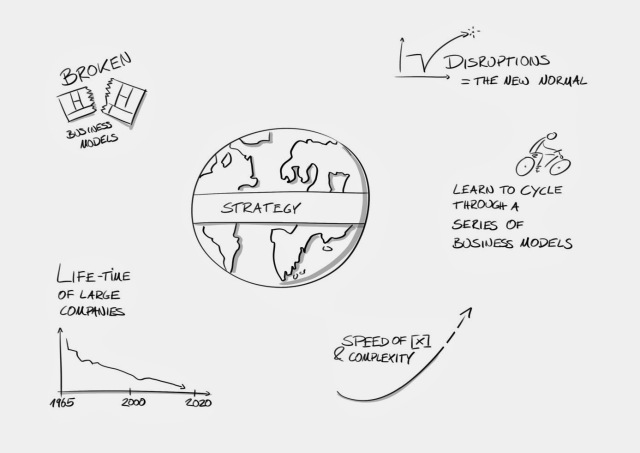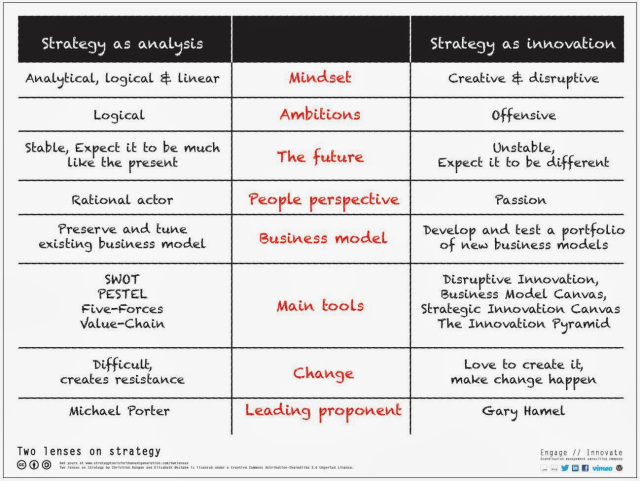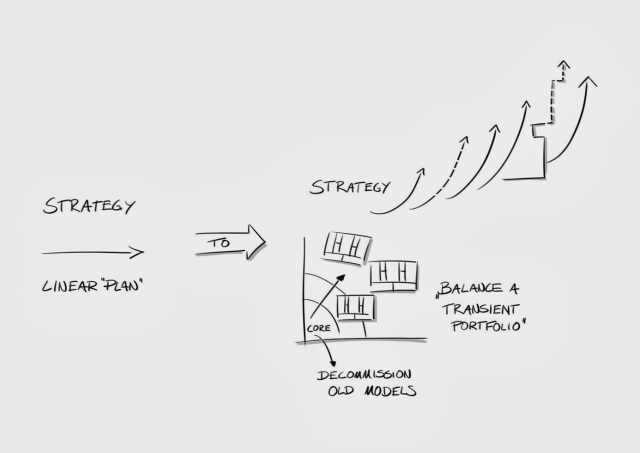
We recently had a chance to do a Q&A with Christian Rangen & Elisabeth Ovstebo, founders of Engage // Innovate and Strategy Tools for the Next Generation:
From Front End of Innovation Blog
Q: Chris, over the past four years, you and Elisabeth have worked to develop a series of new strategy and innovation tools. Tell us about the background.
A: Sure Valerie. The field of strategy has changed significantly over the last 10 – 15 years. But the tools and practices in most firms around the world hasn’t changed at the same pace. Columbia Professor Rita McGrath, author of "The End of Competitive Advantage" – strategy book of the year 2013- , says Strategy is stuck. We very much concur with her.
Q: So what are these big changes that are happening in the field?
A: When we look at the world of strategy today – the big picture – we see five major trends.

Q: So what should companies do?
A: We recommend two steps:
Number one: companies should move from "strategy as analysis" to "Strategy as innovation". This requires a fundamental shift in how strategy is perceived and requires a change in mindset, ambitions, perspectives on the future and business model logic. This is also where most innovation heroes should direct their energies – connect their burning passion to the strategic context of the firm.

Number two: strategy should shift from a "linear plan built around defending a core business model" to a "continuously shifting through business models, spread across a time horizon". This is the simple core idea behind one of the tools, the Strategic Innovation Canvas. Think of it as juggling a high paced innovation portfolio at a strategic level. This requires constant innovation, proactive change and a series of new management skills. Rita writes well about it in her book.

Q: So why is this so difficult?
A: Well, it shouldn’t be. We have ample research. There are stacks of excellent books on the topic, including "The End of Competitive Advantage", "Game-Changing Strategies", "Strategic Transformation", "Business Model Generation" and "Seizing the White Space" to name a few. But there’s a big gap between reading the material and "doing". We need to move from primarily theories and text, to clear, visual thinking and hands-on training and doing.
Q: And this is where your work around new tools comes in?
A: That’s why we’ve spent the last four years, not only on original research, but on developing visually strong, hands-on, action tools. Tools that are easy to use. Tools that can be learned in a matter of hours. Tools that help executives be more successful with strategy and innovation. Tools like the Innovation Pyramid, Innovation Thinking Modes and Innovation vs. Reaction, to name three, all build on extensive research and background work. But they are easy to understand and easy to put to use, without having to go through all the textbooks themselves. That’s the key. So far we have 14 tools online, with more designs in the pipeline. All of them available for free at www.strategytoolsforthenextgeneration.com, under the Creative Commons philosophy.
Q: Elisabeth, what are some of the effects you’re seeing with firms putting these new tools to use?
A: Well, there are three main effects. First, innovation quickly comes an integral part of strategy. People see that new thinking and new ideas – strategic creativity – becomes a core asset. Tools like Strategic Innovation Canvas and Three Levels of Business Models just enables this very natural move of strategy = innovation Second, strategy becomes much more of a dynamic and inclusive process, through more creative workshops and lots of visual thinking. Working with visual strategy facilitators, like Holger Nils Pohl is just a fantastic experience. He will also be joining our workshop, by the way. Finally, people develop a shared understanding, a shared language and shared action around strategy. Alex Osterwalder has worked energetically to design a shared language around business models. We’re seeing the same thing around the wider field of strategy. We should also add, for most clients, we make strategy fun and exciting again – like it should be. Teams we work with drive strategy with a far more innovative mindset and as a result a more innovative strategy follows.
Q: And you will cover some these tools in your workshop?
A: Yes, we will. We are very happy to get a chance to present and share our work at FEI. This is a fabulous arena with fellow innovators from around the world. We always learn so much. Our workshop will be very much a hands-on, doing, working session. It’s pretty exciting to put 25 – 30 executives in the same room and see them work with each other, quickly helping each other solve actual strategy and innovation challenges. While we will use some cases, like Tesla Motors, Google and Amazon; our focus is doing and learning. We want to see people master new tools in 3 hours – rather than just hear about them. We try to stay very interactive.
Q: Chris, what are some of the challenges you’re facing when working with these tools?
A: Throughout our executive education programs, our workshops and consulting projects, we see two key challenges.
The first is "lack of time". Over and over again, we find key management groups being simply too busy, too operational to contemplate fundamental shifts to their strategic logic. For many, replying e-mails and handling current clients gets all their attention. The day-to-day operation gets in the way of time to seriously dive into new strategy tools and radically change the trajectory of their futures. We call it the "pull of the present". In our experience, this is clearly the biggest challenge.
Second, is a perceived a lack of strategic creativity. "I’m not a creative person" or even worse, "we are not an innovative team". We hear this a lot. But it’s not true. Building on the words of David Kelley of IDEO, "Anybody can be strategically creative - you just have to learn how" (ok, so we added strategically). His recent book, Creative confidence, is a great read on this subject. But really, we spend a significant amount of time building creative thinking skills and revealing how the mind actually works – and how this impacts and inhibits our innovative thinking. Once teams crack this code, creative strategic options flow forward and truly create engagement and buy-in.
Q: On a closing note, what would be your top two advices on what not to do for firms moving into 2014 on the topics we are discussing?
A: Number one; don’t believe your present core business model will last as long as you think.
With the speed of change increasing exponentially, a lot of companies will face disruption and industry upheaval in the coming decade. Start laying the groundwork for your next series of core businesses models today.
Number two; don’t treat strategy and innovation as two separate disciplines.
The strategy people and the innovation people should be connected at multiple levels. They should run joint programs, workshops and company-wide processes. Working together, they should define strategy roadmaps, experiment with new business models, run innovation portfolios and redefine the way strategy gets done. This is truly where innovation needs to be happening, at a strategic level.
Editor’s Note:
Christian Rangen & Elisabeth Ovstebo are founders of Engage // Innovate and Strategy Tools for the Next Generation. They are strategy & innovation consultants, business school lecturers, authors, frequent innovation speakers and happy owners of a Brazilian management camp. Christian is also a member of FEI’s advisory board.
Since 2010 they’ve been on a mission to develop new strategy & innovation tools. So far, 14 tools are published at www.strategytoolsforthenextgeneration.com. They work with multinational companies to establish new innovation and strategy practices. They also run Engage // Innovate Ventures, investing in disruptive business ideas.
www.engage-innovate.com
@engageinnovate
Meet Christian & Elisabeth at their half-day workshop, "Your Future Innovation Tools: Strategy Tools for the Next Generation" at Front End of Innovation, Munich and Venice.
* All illustrations by Holger Nils Pohl and Christian Rangen.